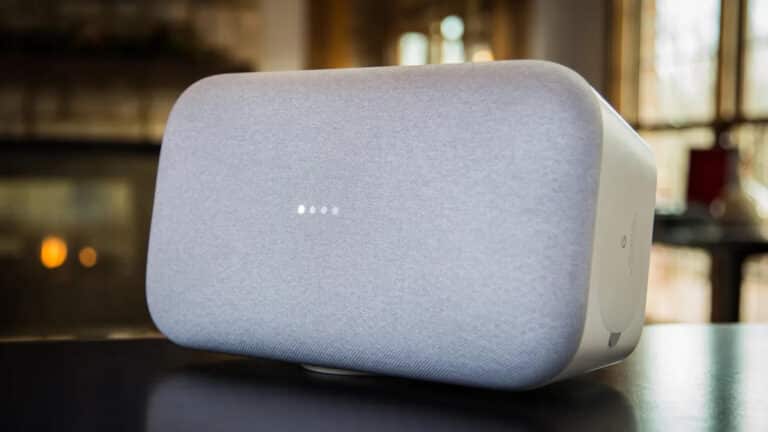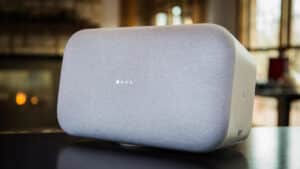The Google Home Max might be your next best friend when you’ve been waiting for an elevated smart speaker with built-in Google Assistant compatibility and you’re tired of the Google Home, Google Home Mini, or Chromecast Audio’s low-sonic prowess.
It’s $399 / £399 / AU$549 plus-sized speakers feature Google’s minimalist look and come with a hefty price tag – however, the excellent sound is exactly what you’d expect for the money.
At first glance, it’s unclear to whom Google Home Max suits best. It may not tempt serious audiophiles, considering that a high-quality receiver and bookshelf speakers can have for nearly the same price. But Google’s commitment to outstanding sound delivery plus support for high-fidelity file types – FLAC, HE-AAC, & LPCM, to name a few – is unrivaled.
As is customary, the source determines how the final product will sound. Even with Google Play Music music streaming, the Google Home Max sounds luxurious enough to justify its price.
What you will see here?
Design

The Google Home Max calls properly, measuring 13.2 x 7.4 x 6 inches & weighs 11.7 pounds. It’s even bigger than two Sonos One speakers stacked on top of each other. Google, on the other hand, made this speaker as unobtrusive as possible. The front is made of grey fabric, while the back and sides are made of white plastic and are roughly trapezoidal in shape & tapered toward the back.
Touch buttons for raising and reducing the volume, as well as a play/pause button, are located on the top of one of the long sides. The speaker can place in either a horizontal or vertical posture. But using the volume controls while the speaker is standing on its own end is problematic.
A switch to turn the microphone on & off, a USB-C port, as well as and all of the 3.5mm audio jacks are situated on the back of the Max. The latter is fantastic for folks who want to use Max to drive their TV audio (something That wish the Sonos One can do), but an optical sound port would have been preferable.
Bluetooth 4.2 is there, as well as 2.4 and 5 GHz 802.11ac Wi-Fi. I’m sure audiophiles would like an Ethernet jack (like on the Sonos One) to assure a stable audio connection, but for the most part, Wi-Fi should be sufficient. The Max is loud enough on its own, but if you want absolutely booming audio, you can combine it with another Max.
Specifications
- Two 4.5′′ dual voice coil woofers with high excursion, and two 0.7′′ bespoke tweeters.
- Fabric that is acoustically transparent and comes in two hues (“chalk” and “charcoal”).
- USB-C input, Google Chromecast, Bluetooth, 3.5 mm headphone jack.
- Stereo pair is possible.
- There is no power source.
- Google Home is a Google-created virtual assistant.
- 33.6 centimeter (13.2 inches) x 19 centimeter (7.4 inches) x 15.4 cm (6.0 in).
- 5.3 kg in weight (11.7 lbs).
Performance

Dual 4.5-inch woofers & dual 0.7-inch tweeters are housed inside the enormous Max, delivering some absolutely incredible sound.
Smart Sound adapts the speaker’s qualities to the environment it’s in. It’s comparable to Sonos’ TruePlay function, except that Sonos requires you to move your phone all around the room physically throughout the tuning process.
The first song you put on the Max was Belle & Sebastian’s “Another Sunny Day,” which had clean vocals but a bass line that was a little too boomy for my liking. The equalization settings inside the Google Home app may adjust manually, thankfully.
Google Home Max Sound performance

On “You Won’t Back Down,” Tom Petty’s choked voice was audible, but the chorus sounded compressed. On “Beast of Burden,” Mick Jagger sounded fantastic, and so did Keith Richard’s guitar licks.
The Max sounds fantastic, but you were intrigued to compare it against the Sonos One, the best-sounding
That bass line in Robert Springsteen’s “Born to Run” was a touch overwhelming on the Max; Clarence’s sax solos didn’t pop as much as I’d like, and Bruce’s vocals didn’t pop as much as I’d want. These Sonos Ones were much more trebly, but Bruce’s voice, as well as Clemons’ sax, were more forward to distinct. Higher tones, such as cymbal crashes, were, nevertheless, a little harsh on the Sonos. To match the volume of the Max, You had to turn the volume up on the Sonos speaker a little more.
When you were listening to the Beastie Boys’ “Sabotage,” You saw a similar pattern. The Max speakers were far more forward in the mids & trebles. While the Sonos speakers were much more forward in the bass.
More deeper bass
Paul Desmond’s sax sounded mellifluous when he played “Take Five” here on Google Home Max; it appeared to soar over the piano & drums. Dave Brubeck’s piano was more prominent on the Sonos Ones, as did the sax melody; this was sharper, but it’s not as warming as on the Max. The drum solo on the Sonos One was sharper & crisper than on Max. You could even hear fingers strumming the bass on the Sonos One.
It was ultimately too close to decide between the dual Sonos Ones as well as the solitary Google Max. The Max had a deeper bass and became more powerful overall. Although the Sonos speakers had more definition plus since there were 2 of them, more versatility in where they could place in the room.
YouTube Music, Spotify, Google Play Music, Pandora, TuneIn, and iHeartRadio are some of the streaming services available. That’s a solid combination, but Sonos offers a lot more, including Last.FM, Soundcloud, MLB, and others.
Is Alexa a better search engine than Google?

A voice assistant is at the heart of any smart speaker. It can do a variety of activities simply by speaking to it. The Google Assistant merge into the Google Home Max. It can do it all from controlling the music & TV to making reservations & turning on and off your lights. In addition to answering queries, Google Assistant can provide weather and traffic updates, manage your calendar, set alarms, and more.
In a three-way battle with Alexa or Siri, Google Assistant came top by a single point over Alexa. When it comes to basic knowledge, entertainment, or voice recognition, Google was the best. Alexa, on the other hand, was superior in terms of smart-home capabilities, music, and online shopping.
Although the Sonos One is just an Alexa-enabled speaker, it does not contain all of Alexa’s features. The Drop-In feature isn’t available with the Sonos Ones. You can’t group these with non-Sonos speakers for the whole music. The all-new Echo ($99) & Echo Show ($229) are
Is Google Home Max still available for purchase?

The Google Home Max, a smart speaker designed for high-quality sound, is no longer being manufactured by Google, and the device has sold out on the Google Store.
The introduced Max was first in the United States on December 11th, 2017 at $399 / AU$549 (about £300), and it was ultimately released in Canada on May 16th, 2018. The Google Max globe tour continued with a stop in Australia on August 9. Followed by a trip to the United Kingdom on August 30.
When the first Google Home was first unveiled, it was a similar story. The speaker, like the Google Home Max, was first only available in North America and released in other countries after about six months.
Conclusion
Overall, You blew away by the Google Home Max. It has booming speakers, can link to your TV, and uses Google Assistant to control your smart home gadgets. But, at $400, it costs twice as much as the Alexa-enabled Sonos One or $50 more than Apple’s impending HomePod.
Read more:
- Set up Sonos speakers and control them on your iPhone!
- Sonos Move review- Sonos’ first portable speaker!
- Setting up a Sonos speaker to work with AirPlay 2!
- Sonos Arc Home theater: Sleek, powerful, and Dolby Atmos-compatible!
















